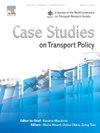Impact of high-speed railway construction on freight capacity on sections of existing railways- A case on the Yangtze River Delta
IF 2.4
Q3 TRANSPORTATION
引用次数: 0
Abstract
The construction of high-speed railway (HSR) can effectively release the freight capacity of existing railways. By analyzing the influencing factors of passengers’ travel choices, the Utility Function and Logit model are adopted to calculate the utility and passenger flow split rate, and get the passenger flow of the existing railways after the diversion of the newly-built HSR. The passenger flow allocation model is established based on User Equilibrium, and improved Frank-Wolfe (FW) algorithm is applied to solve it, and obtain the passenger capacity of the sections on existing railways. Based on the deduction coefficient method, the passenger capacity is deducted from total capacity to get the freight capacity of each section on existing railways after release. Finally, take the railway channel in the Yangtze River Delta as a case, the results show that after the construction of the HSR, the freight capacity of sections on existing railways in the Yangtze River Delta is released to varying degrees. The freight capacity of Hefei-Wuhu section will be released the most, which is 19.5 pairs of trains, while that of Shanghai-Jiaxing section is the least, which is only 3.5 pairs, following by Wenzhou-Jinhua and Hangzhou-Ningbo sections, which are 4 pairs. Therefore, the construction of HSR should be accompanied by focusing on sections with less released freight capacity to enhance the overall capacity of the regional railway network.
高速铁路建设对既有铁路路段货运能力的影响--以长江三角洲为例
高速铁路的建设可以有效释放既有铁路的货运能力。通过分析旅客出行选择的影响因素,采用效用函数和 Logit 模型计算效用和客流分流率,得到新建高铁分流后既有铁路的客流情况。建立基于用户均衡的客流分配模型,并采用改进的 Frank-Wolfe (FW) 算法进行求解,得到既有铁路各区段的客运能力。根据扣除系数法,从总运力中扣除客运运力,得到放行后既有铁路各区段的货运运力。最后,以长三角铁路通道为例,结果表明,高铁建成后,长三角既有铁路各区段货运能力均有不同程度的释放。其中,合肥至芜湖段的货运能力释放最多,为 19.5 对列车;上海至嘉兴段的货运能力释放最少,仅为 3.5 对列车;其次是温州至金华段和杭州至宁波段,均为 4 对列车。因此,在建设高铁的同时,应重点关注货运能力释放较少的区段,以提高区域铁路网的整体运能。
本文章由计算机程序翻译,如有差异,请以英文原文为准。
求助全文
约1分钟内获得全文
求助全文

 求助内容:
求助内容: 应助结果提醒方式:
应助结果提醒方式:


